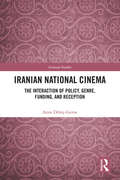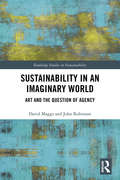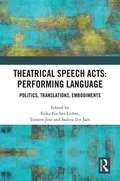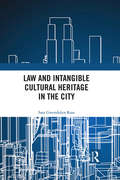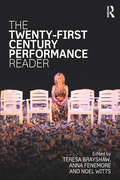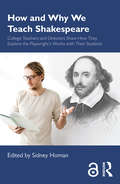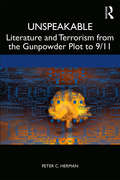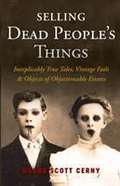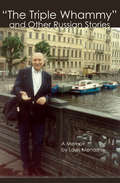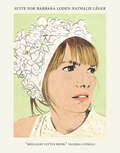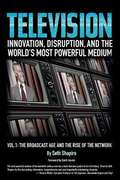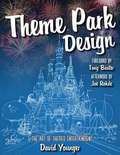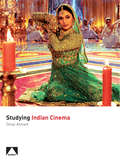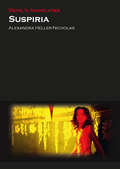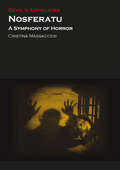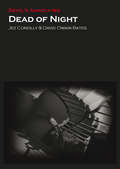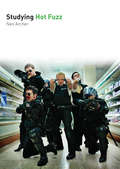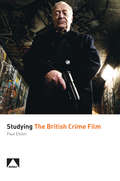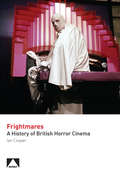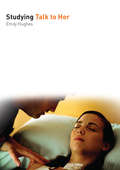- Table View
- List View
Iranian National Cinema: The Interaction of Policy, Genre, Funding and Reception (Iranian Studies)
by Anne Demy-GeroeThis book examines transformations in the production and domestic and international reception of Iranian cinema between 2000 and 2013 through the intersection of the political markers – the presidential terms of Reformist president Mohammad Khatami and his successor, the conservative Mahmoud Ahmadinejad – and filmic markers, particularly Jafar Panahi’s The Circle (2000) and Asghar Farhadi’s About Elly (2009). Through extensive field and media research, the book considers the interaction of a range of factors including government policy, Iranian national cinema genres and categories, intended audience, funding source, and domestic and international reception, to demonstrate the interplay between filmmakers and the government over these two successive presidencies. While the impact of politics on Iranian filmmaking has been widely examined, this work argues for a more nuanced understanding of politics in and of the Iranian cinema than has generally been previously acknowledged. Drawing on both personal experience as a juror at the Fajr International Film festival and interviews with significant filmmakers, producers, actors and other industry insiders, including senior bureaucrats and politicians, the volume is a key resource for anyone interested in politics and Iranian cinema.
Sustainability in an Imaginary World: Art and the Question of Agency (Routledge Studies in Sustainability)
by John Robinson David MaggsSustainability in an Imaginary World explores the social agency of art and its connection to complex issues of sustainability. Over the past decade, interest in art’s agency has ballooned as an increasing number of fields turn to the arts with ever-expanding expectations. Yet just as art is being heralded as a magic bullet of social change, research is beginning to throw cautionary light on such enthusiasm, challenging the linear, prescriptive, instrumental expectations such transdisciplinary interactions often imply. In this, art finds itself at a treacherous crossroads, unable to turn a deaf ear to calls for help from an increasing number of ostensibly non-aesthetic fields, yet in answering such prescriptive urgencies, jeopardizing the very power for which its help was sought in the first place. This book goes in search of a way forward, proposing a theory of art aiming to preserve the integrity of arts practices within transdisciplinary mandates. This approach is then explored through a series of case studies developed in collaboration with some of Canada’s most prominent artists, including internationally renowned nature poet Don McKay; Italian composer and Head of Vancouver New Music, Giorgio Magnanesi; the renowned Electric Company Theatre, led by Kevin Kerr; and finally through a largescale multimedia installation aiming to reimagine the relationship between climate, culture, and human agency. Sustainability in an Imaginary World will be of great interest to students and scholars of arts-based research fields, sustainability studies, and environmental humanities.
Theatrical Speech Acts: Politics, Translations, Embodiments
by Erika Fischer-Lichte Torsten Jost Saskya Iris JainTheatrical Speech Acts: Performing Language explores the significance and impact of words in performance, probing how language functions in theatrical scenarios, what it can achieve under particular conditions, and what kinds of problems may arise as a result. Presenting case studies from around the globe—spanning Argentina, Egypt, Germany, India, Indonesia, Korea, Kenya, Nigeria, Rwanda, Thailand, the UK and the US—the authors explore key issues related to theatrical speech acts, such as (post)colonial language politics; histories, practices and theories of translation for/in performance; as well as practices and processes of embodiment. With scholars from different cultural and disciplinary backgrounds examining theatrical speech acts—their preconditions, their cultural and bodily dimensions as well as their manifold political effects—the book introduces readers to a crucial linguistic dimension of historical and contemporary processes of interweaving performance cultures. Ideal for drama, theater, performance, and translation scholars worldwide, Theatrical Speech Acts opens up a unique perspective on the transformative power of language in performance.
Law and Intangible Cultural Heritage in the City
by Sara Gwendolyn RossWith disappearing music venues, and arts and culture communities at constant risk of displacement in our urban centers, the preservation of intangible cultural heritage is of growing concern to global cities. This book addresses the role and protection of intangible cultural heritage in the urban context. Using the methodology of Urban Legal Anthropology, the author provides an ethnographic account of the civic effort of Toronto to become a Music City from 2014-18 in the context of redevelopment and gentrification pressures. Through this, the book elucidates the problems cities like Toronto have in equitably protecting intangible cultural heritage and what can be done to address this. It also evaluates the engagement that Toronto and other cities have had with international legal frameworks intended to protect intangible cultural heritage, as well as potential counterhegemonic uses of hegemonic legal tools. Understanding urban intangible cultural heritage and the communities of people who produce it is of importance to a range of actors, from urban developers looking to formulate livable and sustainable neighbourhoods, to city leaders looking for ways in which their city can flourish, to scholars and individuals concerned with equitability and the right to the city. This book is the beginning of a conservation about what is important for us to protect in the city for future generations beyond built structures, and the role of intangible cultural heritage in the creation of full and happy lives. The book is of interest to legal and sociolegal readers, specifically those who study cities, cultural heritage law, and legal anthropology.
The Twenty-First Century Performance Reader
by Noel Witts Teresa Brayshaw Anna FenemoreThe Twenty-First Century Performance Reader combines extracts from over 70 international practitioners, companies, collectives and makers from the fields of Dance, Theatre, Music, Live and Performance Art, and Activism to form an essential sourcebook for students, researchers and practitioners. This is the follow-on text from The Twentieth-Century Performance Reader, which has been the key introductory text to all kinds of performance for over 20 years since it was first published in 1996. Contributions from new and emerging practitioners are placed alongside those of long-established individual artists and companies, representing the work of this century’s leading practitioners through the voices of over 140 individuals. The contributors in this volume reflect the diverse and eclectic culture of practices that now make up the expanded field of performance, and their stories, reflections and working processes collectively offer a snapshot of contemporary artistic concerns. Many of the pieces have been specially commissioned for this edition and comprise a range of written forms – scholarly, academic, creative, interviews, diary entries, autobiographical, polemical and visual. Ideal for university students and instructors, this volume’s structure and global span invites readers to compare and cross-reference significant approaches outside of the constraints and simplifications of genre, encouraging cross-disciplinary understandings. For those who engage with new, live and innovative approaches to performance and the interplay of radical ideas, The Twenty-First Century Performance Reader is invaluable.
How and Why We Teach Shakespeare: College Teachers and Directors Share How They Explore the Playwright’s Works with Their Students
by Sidney HomanIn How and Why We Teach Shakespeare, 19 distinguished college teachers and directors draw from their personal experiences and share their methods and the reasons why they teach Shakespeare. The collection is divided into four sections: studying the text as a script for performance; exploring Shakespeare by performing; implementing specific techniques for getting into the plays; and working in different classrooms and settings. The contributors offer a rich variety of topics, including: working with cues in Shakespeare, such as line and mid-line endings that lead to questions of interpretation seeing Shakespeare’s stage directions and the Elizabethan playhouse itself as contributing to a play’s meaning using the "gamified" learning model or cue-cards to get into the text thinking of the classroom as a rehearsal playing the Friar to a student’s Juliet in a production of Romeo and Juliet teaching Shakespeare to inner-city students or in a country torn by political and social upheavals. For fellow instructors of Shakespeare, the contributors address their own philosophies of teaching, the relation between scholarship and performance, and—perhaps most of all—why in this age the study of Shakespeare is so important.
Unspeakable: Literature and Terrorism from the Gunpowder Plot to 9/11
by Peter C. HermanUnspeakable: Literature and Terrorism from the Gunpowder Plot to 9/11 explores the representation of terrorism in plays, novels, and films across the centuries. Time and time again, writers and filmmakers including William Shakespeare, Joseph Conrad, Henry James, Gillo Pontecorvo, Don DeLillo, John Updike, and Steven Spielberg refer to terrorist acts as beyond comprehension, “a deed without a name,” but they do not stop there. Instead of creating works that respond to terrorism by providing comforting narratives reassuring audiences and readers of their moral superiority and the perfidy of the terrorists, these writers and filmmakers confront the unspeakable by attempting to see the world from the terrorist’s perspective and by examining the roots of terrorist violence.
Selling Dead People's Things: Inexplicably True Tales, Vintage Fails and Objects of Objectionable Estates
by Duane Scott CernyChicago antiques dealer Duane Scott Cerny gives a behind-the-curtain peek into the world of antiques and their obsessive owners--while still alive and after their passing. Whether processing the estate of a hoarding beekeeper, disassembling the retro remains of an infamous haunted hospital, or conducting an impromptu appraisal during a shiva gone disturbingly wrong, every day is a twisted treasure hunt for this twenty-first-century antiques dealer. While digging deep into the basements, attics, and souls of the most interesting collectors imaginable, traveling from one odd house call to the curious next, resale predicaments will confound your every turn. Be careful where you step, watch what you touch, and gird your heart--Antiques Roadshow, this ain't!
"The Triple Whammy" and Other Russian Stories: A Memoir
by Luis MenasheAn American historian, film specialist, and documentary filmmaker shares candid stories of his life in Russia during and after the Cold War. A captivating lifetime of personal and professional experiences by an American historian, film specialist, and documentary filmmaker in the Soviet Union and post-Soviet Russia. The author&’s experiences as a radical in the turbulent 1960s, and his eventual disenchantment offer some precedents and perspectives to all those on the Left, Center, or Right interested in the fluctuations of American politics. The vivid log of hopes and disillusions is related in a candid, non-academic style, and set against a panorama of history and politics in the late twentieth century.&“A self-described scholar-activist, Menashe weaves together political, intellectual, and cultural currents of leftist life, and draws a vivid picture of people and places, life-changing adventures, the intellectual and political challenges of graduate school during the Cold War, encounters with key Russian literary and political figures, and much more. Then comes the crash, the Soviet Union&’s end. As in all failed love affairs, Menashe retains some sweet memories. The reader will taste them long after reading the memoir.&” —Carole Turbin, Professor Emerita, History and Sociology, SUNY/Empire State College
Suite for Barbara Loden
by Nathalie LégerThe second in Nathalie Léger&’s acclaimed genre-defying triptych of books about the struggles and obsessions of women artists. &“I believe there is a miracle in Wanda,&” wrote Marguerite Duras of the only film American actress Barbara Loden ever wrote and directed. &“Usually, there is a distance between representation and text, subject and action. Here that distance is completely eradicated.&” It is perhaps this &“miracle&”—the seeming collapse of fiction and fact—that has made Wanda (1970) a cult classic, and a fascination of artists from Isabelle Huppert to Rachel Kushner to Kate Zambreno. For acclaimed French writer Nathalie Léger, the mysteries of Wanda launched an obsessive quest across continents, into archives, and through mining towns of Pennsylvania, all to get closer to the film and its maker. Suite for Barbara Loden is the magnificent result.
Television: The Broadcast Age and the Rise of the Network
by Seth ShapiroNo medium in history can match the power of television. No product has spread so far and so fast. Nothing has had so much influence. Nothing has impacted how the world sees itself like television. TELEVISION: Volume 1 brings together seven decades of stories on how this happened into one epic narrative. How did an impoverished immigrant become the king of all media, creating the first radio network and the first TV network? What caused the inventor of FM radio to jump out of a window to his death? How did NBC, CBS and ABC innovate to build their media monopolies? How did Star Trek create the first fan culture movement? What made The Mary Tyler Moore Show the first great feminist show, and #1 hit? What made Norman Lear the most influential TV comedy producer ever? How did Lucille Ball go from a washed-up B movie actress to a multi-millionaire Hollywood studio mogul? What makes Louis C. K. the Jackie Gleason of the digital age? With unparalleled insider insight, it shares critical, practical, behind the scenes lessons from the business of TV. The TELEVISION series is a must-read for media executives, students, entrepreneurs, and fans. Two-time Emmy(R) Award winner, author Seth Shapiro is a leading advisor in business innovation, media and technology. He is an Adjunct Professor at the USC School of Cinematic Arts, a Governor of the Television Academy, and Principal of New Amsterdam Media LLC.
This School is Driving Me Nuts: And Other Funny Plans for Kids
by Craig Smith Fiona Mcdonald Duncan BallThis hilarious collection of nine short plays for kids, written by popular author Duncan Ball, ranges from a comic monologue to a play that can involve a whole class, and everything in between. It will suit use both in the classroom and on stage, as well as being lots of fun to read at home. Capturing the imagination and tickling the funny bones of young readers and actors, the plays range from spoof mystery to fantasy to school capers, all with a great zing of humour. The book also includes tips on staging the plays. Originally published as Comedies for Kids in 1988, this fabulous collection has been fully revised and updated by the author, with a brand new play, The Teeth of a Vampire, added. The lively cover and internal illustrations are by well-known illustrator Craig Smith. Cover and internal design by Fiona McDonald. Recommended for children aged 7-12.
Theme Park Design and the Art of Themed Entertainment
by David YoungerWant to design a theme park? Over the past century, theme parks have created worlds where pirates still loot Caribbean towns, where daring adventurers explore booby-trapped temples, and where superheroes swing from New York skyscrapers - and allowed us to step into them too. This is a book about how to design those fantastic places, and the ingenuity that goes into their creation. This is a handbook for the practicing designer, a textbook for the aspiring student, and a behind the scenes guidebook for the theme park fan, building on hundreds of interviews with accomplished designers from Walt Disney Imagineering, Universal Creative, Merlin Entertainments, and more. Theme Park Design & The Art of Themed Entertainment explores everything from the stories, themes, and characters that theme parks bring to life, to the business models, processes, and techniques that allow them to do it. From rocket ships to roller coasters, fairy tales to fireworks, and dinosaurs to dark rides, never before has a book dived so deep into the art form of themed entertainment.
Studying Indian Cinema (Auteur)
by Omar AhmedThis book traces the historical evolution of Indian cinema through a number of key decades. The book is made up of 14 chapters with each chapter focusing on one key film, the chosen films analysed in their wider social, political and historical context whilst a concerted engagement with various ideological strands that underpin each film is also evident. In addition to exploring the films in their wider contexts, the author analyses selected sequences through the conceptual framework common to both film and media studies. This includes a consideration of narrative, genre, representation, audience and mise-en-scene. The case studies run chronologically from Awaara (The Vagabond, 1951) to The Elements Trilogy: Water (2005) and include films by such key figures as Satyajit Ray (The Lonely Wife), Ritwick Ghatak (Cloud Capped Star), Yash Chopra (The Wall) and Mira Nair (Salaam Bombay!).
Suspiria (Devil's Advocates)
by Alexandra Heller-NicholasAs one of the most globally recognisable instances of 20th century Eurohorror, Dario Argento’s Suspiria (1976) is poetic, chaotic, and intriguing. The cult reputation of Argento’s baroque nightmare is reflected in the critical praise it continues to receive almost 40 years after its original release, and it appears regularly on lists of the greatest horror films ever. For fans and critics alike, Suspiria is as mesmerising as it is impenetrable: the impact of Argento’s notorious disinterest in matters of plot and characterisation combines with Suspiria’s aggressive stylistic hyperactivity to render it a movie that needs to be experienced through the body as much as through emotion or the intellect. For its many fans, Suspiria is synonymous with European horror more broadly, and Argento himself is by far the most famous of all the Italian horror directors. If there was any doubt of his status as one of the great horror auteurs, Argento’s international reputation was solidified well beyond the realms of cult fandom in the 1990s with retrospectives at both the American Museum of the Moving Image and the British Film Institute. This book considers the complex ways that Argento weaves together light, sound and cinema history to construct one of the most breathtaking horror movies of all time, a film as fascinating as it is ultimately unfathomable.
Nosferatu: A Symphony of Horror (Devil's Advocates)
by Cristina MassaccesiNosferatu: A Symphony of Horror, directed by German director Friedrich Wilhelm Murnau in 1922, is not only regarded as one of the most intriguing and disquieting films to have been produced during the years of Weimar cinema but is also a key step in establishing the vampire as a cinematic figure and in shaping its connection with our subconscious fears and desires. In her analysis of this hugely influential film, Cristina Massaccesi unravels the never-ending fascination exercised by the film over generations of viewers and filmmakers whilst at the same time providing the reader with a clear guide about the film's contexts, cinematography, and possible interpretations, covering the political and social context of the Weimar Republic and its film industry, the German Expressionist movement, the film's production, reception and difficult initial release. The book also includes the results of a lengthy interview between the author and E. Elias Merhige, director of the Nosferatu homage, Shadow of the Vampire (2000).
Dead of Night
by Jez Conolly David O. BatesReleased a matter of days after the end of the Second World War and a dozen years ahead of the first full-blooded Hammer Horror, the Ealing Studios horror anthology film Dead of Night featured contributions from some of the finest directors, writers and technicians ever to work in British film. Since its release it has become evermore widely regarded as a keystone in the architecture of horror cinema, both nationally and internationally, yet for a film that packs such a reputation this is the first time a single book has been dedicated to its analysis. Beginning with a brief plot précis 'road map' in order to aid navigation through the film's stories, there follows a discussion of Dead of Night's individual stories, including its frame tale ('Linking Narrative'), a consideration of the potency of stillness and the suspension of time as devices for eliciting goose bumps, an appraisal of the film in relation to the very English tradition of the festive ghost story, and an analysis of the British post-war male gender crisis embodied by a number of the film's protagonists. The book includes a selection of rarely seen pre-production designs produced by the film's acclaimed production designer, Michael Relph.
Dead of Night (Devil's Advocates)
by Jez Conolly David O. BatesReleased a matter of days after the end of the Second World War and a dozen years ahead of the first full-blooded Hammer Horror, the Ealing Studios horror anthology film Dead of Night featured contributions from some of the finest directors, writers and technicians ever to work in British film. Since its release it has become evermore widely regarded as a keystone in the architecture of horror cinema, both nationally and internationally, yet for a film that packs such a reputation this is the first time a single book has been dedicated to its analysis. Beginning with a brief plot précis 'road map' in order to aid navigation through the film's stories, there follows a discussion of Dead of Night's individual stories, including its frame tale ('Linking Narrative'), a consideration of the potency of stillness and the suspension of time as devices for eliciting goose bumps, an appraisal of the film in relation to the very English tradition of the festive ghost story, and an analysis of the British post-war male gender crisis embodied by a number of the film’s protagonists. The book includes a selection of rarely seen pre-production designs produced by the film’s acclaimed production designer, Michael Relph.
Studying Hot Fuzz (Studying Films)
by Neil ArcherBy the power of Greyskull! In their second big-screen collaboration after Shaun of the Dead (2004), with Hot Fuzz (2007) director and co-writer Edgar Wright and co-writer and star Simon Pegg took aim at the conventions of the Hollywood action movie, transplanting gratuitous slo-mo action sequences into the English village supermarket and local pub. In this first critical study of arguably the most influential British film-makers to emerge this century, Neil Archer considers to what extent a modestly funded film such as this can be considered 'British' at all, given its international success and distribution by an American studio, and how far that success depends upon what he calls its 'cultural specificity'. He considers the film as a parody of the action movie genre, and discusses exactly how parody works – not just in relation to the conventions of the action film but also in the depiction of English space. Exactly what and who is Hot Fuzz poking fun at?
Studying the British Crime Film
by Paul ElliottEver since its inception, British cinema has been obsessed with crime and the criminal. One of the first narrative films to be produced in Britain, the Hepworth's 1905 short Rescued by Rover, was a fast-paced, quick-edited tale of abduction and kidnap, and the first British sound film, Alfred Hitchcock's Blackmail (1930), centered on murder and criminal guilt. For a genre seemingly so important to the British cinematic character, there is little direct theoretical or historical work focused on it. The Britain of British cinema is often written about in terms of national history, ethnic diversity, or cultural tradition, yet very rarely in terms of its criminal tendencies and dark underbelly. This volume assumes that, to know how British cinema truly works, it is necessary to pull back the veneer of the costume piece, the historical drama, and the rom-com and glimpse at what is underneath. For every Brief Encounter (1945) there is a Brighton Rock (2010), for every Notting Hill (1999) there is a Long Good Friday (1980).
Studying the British Crime Film (Studying British Cinema Ser.)
by Paul ElliottEver since its inception, British cinema has been obsessed with crime and the criminal. One of the first narrative films to be produced in Britain, the Hepworth’s 1905 short Rescued by Rover, was a fast-paced, quick-edited tale of abduction and kidnap, and the first British sound film, Alfred Hitchcock’s Blackmail (1930), centered on murder and criminal guilt. For a genre seemingly so important to the British cinematic character, there is little direct theoretical or historical work focused on it. The Britain of British cinema is often written about in terms of national history, ethnic diversity, or cultural tradition, yet very rarely in terms of its criminal tendencies and dark underbelly. This volume assumes that, to know how British cinema truly works, it is necessary to pull back the veneer of the costume piece, the historical drama, and the rom-com and glimpse at what is underneath. For every Brief Encounter (1945) there is a Brighton Rock (2010), for every Notting Hill (1999) there is a Long Good Friday (1980).
Frightmares: A History of British Horror Cinema
by Ian CooperThe horror film reveals as much, if not more, about the British psyche as the heritage film or the social realist drama. But like a mad relative locked in the attic, British horror cinema has been ignored and maligned. Even when it has been celebrated, neglect is not far behind and what studies there have been have been have concentrated largely on the output of Hammer, the best-known producers of British horror. But that is only part of the story. It's a tradition that encompasses work by both celebrated auteurs such as Hitchcock and Polanski, as well as a series of opportunistic, often-unashamed hacks. Frightmares is an in-depth analysis of the home-grown horror film, each chapter anchored by a close study of two or more key titles, consisting of textual analysis, production history, marketing and reception. Although broadly chronological, attention is also be paid to the thematic links, emphasising both the wide-range of the genre and highlighting some of the less-explored avenues. Chapters focus on the origins of British horror and its foreign influences, Hammer (of course), the influence of American International Pictures, notably their Vincent Price films, and other American filmmakers, the 'savage Seventies' and the new wave of twenty-first century British horror.
Frightmares: A History of British Horror Cinema (Studying British Cinema)
by Ian CooperThe horror film reveals as much, if not more, about the British psyche as the more respectable heritage film or the critically revered social realist drama. Yet, like a mad relative locked in the attic, British horror cinema has for too long been ignored and maligned. Even when it has been celebrated, neglect is not far behind and what studies there have been concentrate largely on the output of Hammer, the best-known producers of British horror. But this is only part of the story. It's a tradition that encompasses the last days of British music hall theater, celebrated auteurs such as Alfred Hitchcock and Roman Polanski and opportunistic, unashamed hacks.Frightmares is an in-depth analysis of the home-grown horror film, each chapter anchored by close studies of key titles, consisting of textual analysis, production history, marketing and reception. Although broadly chronological, attention is also paid to the thematic links, emphasizing both the wide range of the genre and highlighting some of its less-explored avenues. Chapters focus on the origins of British horror and its foreign influences, Hammer (of course), the influence of American International Pictures and other American and European filmmakers in 1960s Britain, the 'savage Seventies' and the new wave of twenty-first century British horror. The result is an authoritative, comprehensive and, most importantly, entertaining survey of this most exuberant field of British cinema.
Studying Talk to Her
by Emily HughesTalk to Her (2002) is a hugely rich and interesting, but ambiguous, film which met with both popular success and critical acclaim. The film won the 2003 Oscar for best original screenplay and has been hailed by some critics as Pedro Almodóvar's masterpiece. But like most of Almodóvar's films, little is clear cut; the characters are complex and our affinity and empathy for them shifts throughout the film. In Studying Talk to Her, Emily Hughes provides an in-depth analysis of both the formal elements of the film (narrative, genre, auteur study) and the themes and issues that arise, including the social context of modern Spain and the old traditional iconography, the shifting attitudes towards gender, and, crucially, the uneasy, morally ambiguous depiction of rape and the spectator's reaction to it.
Studying Talk to Her (Studying Films)
by Emily HughesTalk to Her (2002) is a hugely rich and interesting though ambiguous film that met with both popular success and critical acclaim. The film won an Oscar for best original screenplay and has been hailed by some critics as Pedro Almodóvar's masterpiece. Yet like most of Almodóvar's films, little is clear cut. The characters are complex and our affinity and empathy for them shifts throughout the film. In Studying Talk to Her, Emily Hughes provides an in-depth analysis of both the formal elements of the film (its narrative, genre, and auteur study) and the themes and issues it raises, discussing the social context of modern Spain and its old, traditional iconography; shifting attitudes towards gender; and, crucially, the film's uneasy, morally ambiguous depiction of rape and the spectator's reaction to it.
